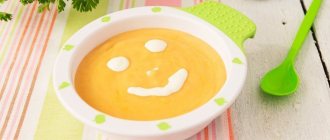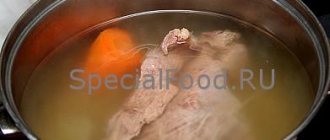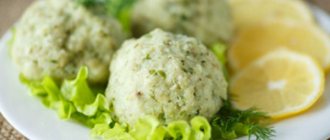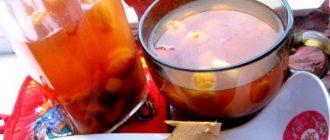How to cook soup for a child: recipes for children's soups
Nutrition for babies up to one year is based on the principle of gradually introducing the child to foods. Due to the physiological characteristics of the formation of the digestive system, the child first drinks milk, then switches to pureed vegetables and fruits. By about 8 months, the baby is ready to introduce a new dish into the diet - soup. The first course stimulates the production of gastric juice, thereby helping to digest second courses, which are heavier due to their consistency.
Read more about introducing new dishes into your baby’s diet in our article on complementary feeding rules. This article will tell you how to cook soup for a child.
Soups are an important source of dietary fiber, vitamins and protein. To preserve all the nutrients, it is better to cook the soup at once, be it vegetable or meat.
How to cook soup for a child
An 8 month old baby's stomach is still weak enough to digest broths. Therefore, the first soups need to be boiled in water. By the end of cooking, the water should remain clear. To achieve this result, you need to drain the first vegetable broth obtained after 25-30 minutes of cooking, then continue cooking the soup with a new portion of water.
Rules for preparing soup for a baby:
- Vegetable soup prepared for a child 8-12 months old should not contain salt. Vegetables and meat already contain a sufficient amount of it; the baby does not need more.
- Vegetable soup must be cooked; frying vegetables in oil is unacceptable. The carcinogens formed during the frying process will not benefit the baby for 8-12 months.
A little later, from 9-10 months, you can introduce meat soup. Be attentive to age restrictions - study the information about when you can introduce meat into complementary foods. You can cook this soup only with a second broth. The same rule applies to soups with meatballs - boil the meat part of the soup separately, drain the first broth, add clean water and continue cooking, adding vegetables.
The first thing in a child’s diet should be vegetable soup. You can cook it from 2-3 vegetables - any except white cabbage. Cauliflower or broccoli can be a great substitute. Potatoes, carrots and onions are perfect for the first soup.
Puree soups do not need to be made too thick, because this is not a replacement for the second course, but a full-fledged first course. You can add cereal (corn or buckwheat) and noodles - store-bought or homemade - to the soup. Children aged 9-12 months will really enjoy this tasty and nutritious lunch.
6 basic recipes for making soup for a baby
Soup recipes for children from 9 to 12 months include the simplest ingredients and are prepared very quickly. Vegetable, meat, dairy - soups for every taste!
Meatball soup
This recipe is more suitable for older children who already know how to chew on their own. It involves using ground beef, but chicken will also work. You need to add an onion to it, previously chopped in a blender. Crumble the bread crumb here, soaked in boiling water for about 5-7 minutes. Mix everything thoroughly. Having formed the meatballs, you need to carefully lower them one by one into a pan of boiling water. Then the first water must be drained, after removing the meatballs, pour in new water, and bring to a boil. While the water is boiling, you need to prepare the vegetables.
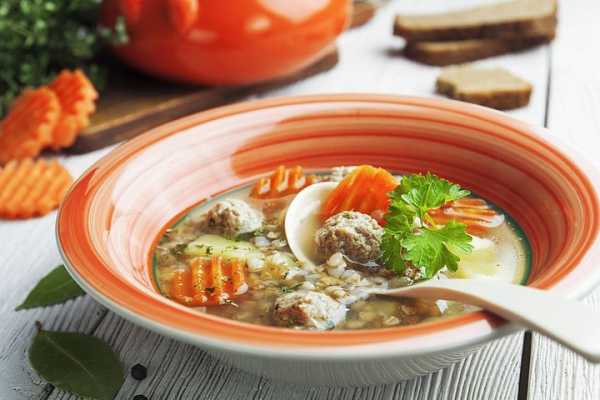
Cut the carrots and potatoes into small cubes or cubes, put them in water along with the meatballs, cook for 15 minutes. The baby will lick his fingers!
Cream soup with rice
For this recipe, cabbage and potatoes need to be washed well and cut. Place the vegetables in a pan of boiling water, wait 5-6 minutes, then pour the washed rice into the pan (by the way, we have an article about the benefits of rice for children). Cook for another 10-12 minutes, remove from heat. When the soup has cooled slightly, mash it with a fork or grind it with a blender.

This soup is considered one of the most nutritious.
Cream soup with carrots and pumpkin
Place diced pumpkin and carrots in water brought to a boil. Cook for 15-20 minutes, let cool slightly, grind with a blender. Add butter to the finished dish. This recipe can be called the most useful. Your little one will love sweet pumpkin.
Milk soup with noodles
Place vermicelli in boiling water, cook for 5-7 minutes over low heat, add milk, keep on fire for another 5 minutes, stirring constantly. At the end of cooking, add a small piece of butter. For this recipe it is better to use goat's milk, because... Cow's milk is poorly digestible and is not recommended by WHO for children under 3 years of age (more about this in the article Can children use cow's milk?).
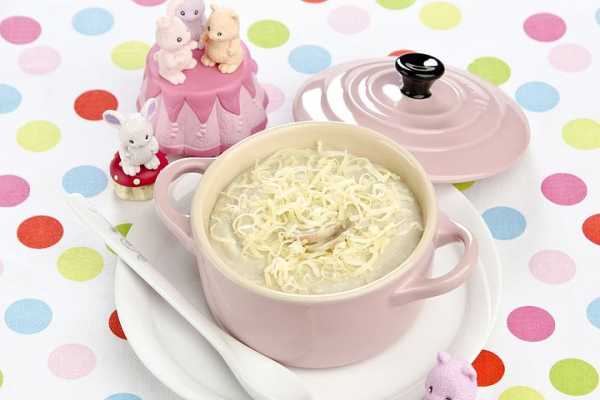
Many kids like this soup more than vegetable soup. Even dads will not refuse him. After all, this is a recipe from childhood.
Creamy potato soup with zucchini
Another vegetable recipe. Chop potatoes and zucchini, peeled. Bring the water to a boil, first put the potatoes in the pan, after 7 minutes add the zucchini, cook for another 15-17 minutes. After removing from the heat, the cooked vegetables need to be cooled and chopped with a blender, add cream to the resulting dish, and mix everything carefully. Simple and quick recipe!
Meat soup
This recipe describes the most delicious soup. To prepare such a dish, you need to cook the meat, veal or beef would be the best option, drain the first broth, add water to the meat again, wait until it is completely cooked, remove from the stove, wait until it cools. Use a blender to grind the meat. Now you need to add vegetables cut into small cubes or cubes into the pan - carrots, potatoes, zucchini, Brussels sprouts and leave to cook until tender. Great recipe. No one has ever refused such a delicious treat!
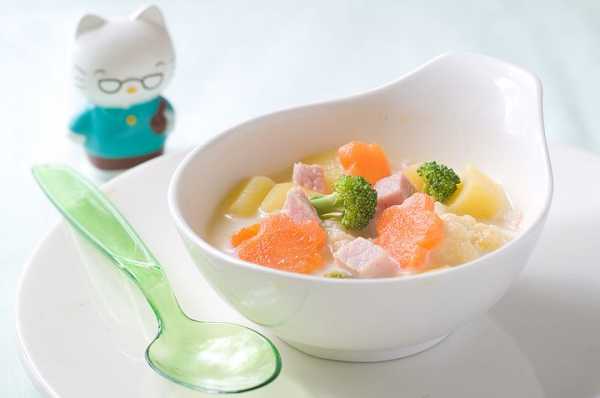
Now you know how to cook soup for a child, and you understand that this is more than simple! We also have an excellent article about cereals for children - read for your health!
In order for the baby to finish a new dish to the last spoon, it is necessary to make it not only tasty, but also beautiful. Carrots can be cut into thin slices and shaped like suns, potatoes and zucchini can be cut into small cubes. In summer you can add greens. With the beauty of the dish comes a big appetite!
For clarity, watch the video on how to cook soup for babies, which we have prepared for you:
What soups have you already prepared for your children? Share your recipes in the comments to help other readers.
Eventually
Now you know everything about how to properly prepare soups for infants using various recipes. Choose the one that you and your baby like best. Try to keep your diet varied, and therefore change your liquid diet periodically.
Feed your child healthy and tasty food so that he develops normally!
Nutrition for babies up to one year is based on the principle of gradually introducing the child to foods. Due to the physiological characteristics of the formation of the digestive system, the child first drinks milk, then switches to pureed vegetables and fruits. By about 8 months, the baby is ready to introduce a new dish to the diet - soup. The first course stimulates the production of gastric juice, thereby helping to digest second courses, which are heavier due to their consistency.
Soups are an important source of dietary fiber, vitamins and protein. To preserve all the nutrients, it is better to cook the soup at once, be it vegetable or meat.
recipes How to cook soup for a child
When a newborn baby reaches the age of 6-7 months, new foods should appear in his diet. In this case, you can feed the baby with breast milk or formula for a long time. One of the most popular children's dishes is cream soup. This will be discussed later. You will learn how to prepare soup for a child under one year old. The recipes will be described below. You will also learn about the features of preparing this dish.
Children's soup: highlights
This dish is introduced into the baby’s diet no earlier than six months. In this case, all the components should already be well known to the baby. Otherwise, an allergic reaction may occur and you will not know which component.
Before preparing soup for your child, carefully study the quality of the selected products. Potatoes and carrots should be fresh, but broccoli and cauliflower should be frozen.
Types of soups for young children
Soup for children under one year old (see recipes below) can have several bases. The most popular are the following:
- meat product;
- vegetable dish;
- borsch;
- fish soup
At this age, you should not give your baby cold liquid dishes, such as tomato, garlic and cheese soup, as well as okroshka.
How to prepare soup for a baby?
So, you've decided to cook a delicious and nutritious dish. First, decide on the composition. As you already know, all components must be of high quality. It is not necessary to choose vegetables of dubious origin. The ideal option is to use products that you grow yourself.
If you add meat, the puree soup should be rabbit, chicken, turkey or veal. Never use lamb or pork for this age. Avoid fatty broths made from bones. It will be better if you take a second decoction. So, how to prepare soup for a child under one year old? Recipes are presented to your attention.
Vegetable product
Vegetable cream soup can contain all the vegetables that your child likes, in which case they should be familiar to the child. The dish is prepared using vegetable broth. Be sure to peel the potatoes first and soak them in cold water. This manipulation will help get rid of starch. If you are using a young product, you can avoid this procedure.
Cut potatoes, onions, carrots into small slices. Place them in cold water and put on fire. When the liquid boils, add pre-peeled zucchini, broccoli, and cauliflower. You can adjust the composition at your discretion. If your baby has problems with bowel movements, then add grated beets and herbs. Cook vegetables until tender (about 20 minutes). After this, remove the container from the heat and remove the products from the broth.
Vegetable cream soup is prepared using a blender. When a child appears in the house, this household appliance will be indispensable. Place all ingredients in a bowl and grind. Add the required amount of vegetable broth and a few teaspoons of olive oil. Mix the contents thoroughly and refrigerate. After this, you can start feeding.
Meat soup
If your baby is already 9 months old, then his diet should include meat. The first soup with this ingredient should have a vegetable base. This means that you need to prepare the product according to the above recipe, but you need to put a few more pieces of freshly baked meat without fat and skin into the blender.
If the baby reacted well to such a dish, then you can diversify it and prepare the soup with a more rich soup. To do this, take boneless meat and cook it. After that, drain the first liquid and repeat the procedure. The second broth will be less fatty and will be better absorbed by the child’s stomach. Once cooked, remove the meat and prepare the vegetables as described above. Mix everything in a blender and add the required amount of prepared broth. Meat cannot be added to such a product, since even without it it turns out fatty.
a fish dish
When preparing fish soup for a child, the meat of sea creatures is used. This fish practically does not have small bones and is more suitable for babies.
Remove meat from bones and rinse. Place in a saucepan and put on fire. It takes about 30 minutes to cook the fish. Don't forget to take off all the time. When the product is ready, add chopped potatoes and carrots. Cook for another 5 minutes. Then you can add any cereals to the soup. It could be buckwheat, rice, pearl barley or whatever your baby likes. Remember that rice soup strengthens the intestines. Should not be used for constipation. When the cereal is ready (about 10 minutes), add a few dill stalks and let the dish sit for half an hour. After this, use a blender to mash the food and you can start feeding the crumbs.
How to make soup for a baby from bags?
Currently, baby food manufacturers offer to buy not only instant cereals and milk, but also soups. To prepare this dish, you just need to dilute it in hot water. Remember that you need to choose a product in accordance with the age of the baby. At the same time, a homemade dish is always preferable.
Soups from packs are convenient to take with you on the road when you can’t stand at the stove and use a blender.
Summing up or a small conclusion about the article
So, now you know how to prepare soup for a child under one year old. Listed above are recipes for popular and healthy dishes. Choose the one your little one likes and cook it. However, the diet should be varied. Periodically change the method of preparing soups. Liquid nutrition must be present in the baby’s diet from 7-8 months. These foods will help your digestive tract. Soups contain vegetables rich in fiber and coarse fibres.
Feed your baby tasty, healthy and nutritious food. He needs this for normal growth and development. Happy soup making!
,
Feeding schedule with delicious recipes
Did your eight month old just attack your plate? Found it cute, right? This is an indicator that the baby is ready to enjoy food. Moreover, the naughty baby now needs more energy than before because she has too much to do, such as crawling and exploring around her.
Then why put it off, offer her some delicious porridge! You would be surprised to see your loved one swallow it. What else could be on the list of the best foods for an 8 month old baby? MomJunction brings you the best meal ideas.
The best food for an 8 month old baby
You may have read a lot about foods to give your baby this month. We know there is so much information out there that it can be overwhelming and confusing. That is why we have compiled the most suitable foods that you can feed your baby in the eighth month.
Breast milk or formula
Breast milk: Continue to offer breast milk to your baby while he is still growing. Breast milk should be her main source of nutrition. Try to provide solid foods as a supplement.
Your baby needs more breast milk in the first six months. But after that, his need for breast milk decreases when you start giving him solid foods (1). The standard milk intake range for a breastfed baby is 19-30 ounces per day (570-900 ml).
How much expressed milk does an eight month old baby need?
Estimate how many times your child drinks milk each day, for example five times. Divide 25 ounces by the number (25/5 = 5 ounces). In this case, you need to express 5 ounces for each feed. However, do not force your baby to finish the bottle, as she may not develop an appetite after eating some solid food.
Infant Formula: Infant formula or baby milk powder provides the same benefits as breast milk. Mix it in a cup and feed it to your child during meals. If your baby refuses a cup, try a bottle.
What to do if your eight month old baby drinks more milk than required?
Ideally, you need to reduce the amount of milk in order to prepare solid food. However, if she drinks more than the average amount of milk, try to find the reasons for this:
- Fast flow bottles may cause a child to drink more than required. Use low flow bottles. Make sure you measure the amount of milk you give her at each feeding.
- A strong urge to suck during breastfeeding can cause your baby to drink more. Prevent this by giving him a pacifier.
Note: At this age, your baby needs between 750 and 900 calories per day. Breast milk or formula should contain between 400 and 500 calories.
Legumes, wheat and rice
Feed your eight-month-old baby boiled, non-spicy lentils. We offer freshly baked and soft chapatis (wheat bread). Avoid multigrain breads.
Cereals
Feed grains that are high in iron such as oats, ragi, barley, etc. The nutrients contained in fortified grains are not present in regular baby foods like breads and vegetables
[Read: High Calorie Foods For Babies ]
4.Fruits
Mash them well, without lumps, and feed them to an eight-month-old baby. Choose from bananas, apples, avocados, pears, strawberries, cherries, peaches and more.
Vegetables
Offer your baby well-cooked and steamed foods. Cut them into small pieces to avoid choking and for easier chewing. The best vegetables at this age are potatoes, cauliflower, beans, peas and sweet potatoes. They make a great snack for 8 month old babies.
Eggs
The egg is rich in protein, nutrients and easy to digest. Start with the egg yolk and once your baby gets used to it, offer the egg white. You can feed her boiled eggs or scrambled eggs, but cut them into small pieces.
Fish and meat
You can offer your eight-month-old baby small pieces of well-cooked meat, but do not add any spices. Good snacks are made from organic lean meat and well-cooked fish, completely deboned.
Pasta
You can give well-fried pasta made from soft wheat or rice. They make an excellent snack. Do not add artificial flavors. You can add a little salt if desired. The best varieties are penne pasta, spiral pasta and pasta. Avoid maida paste.
Some other finger food ideas for an eight month old include oval cereal, well-cooked potato chunks, teething crackers, small bagel pieces, and omelette pieces.
Cheese
Cottage cheese or pieces of pasteurized cheese in limited quantities are suitable for an eight-month-old baby. Too much of anything can lead to an upset stomach or worse.
Note: Your eight month old may already have teeth. Even if she didn't, her jaws would be strong enough to handle small pieces. So, serve lightly pureed, soft and well-cooked foods.
[Read: Baby Food Chart ]
Feeding schedule for an 8 month old baby
Your child needs three meals a day with a snack or two breaks in between. Monitor her hunger cues and establish a daily routine. The amount of food your baby eats may be less, but it should be enough for him due to finger eating and thicker foods.
Also remember that your baby is still adjusting to solids, so don't panic even if she only eats one meal a day.
Offer her a wide variety of nutritious foods. Try to offer the right amount of nutrients each day. For example:
- 1/4 to 1/3 cup dairy (or 1/2 ounce cheese)
- 1/4 to 1/2 cup iron-fortified cereal
- 3/4 to 1 cup fruit
- 3/4 to 1 cup vegetables
- 3 to 4 tablespoons of protein-rich food
Breakfast (early morning)
- Breast milk or formula - about 120 ml
Mid morning (10:00)
- Snack or fruit such as mashed banana or porridge
Lunch (around 12:30)
- Cereals, meats, cheese and vegetables
Noon (15:00)
- Breast milk or formula - about 120 ml
Dinner (from 18:00 to 19:00)
Before bed (20:00)
- Brea st milk or infant formula - about 120 ml
[Read: Top 30 healthy baby foods ]
Simple Homemade Baby Food Recipes for 8 Months Old
Breakfast ideas
1.Suji (semolina) upma
Cooking time: 15min
You will need:
- 1/2 cup semolina or sooji
- 1/4 teaspoon ghee
- 1 glass of water
- a pinch of turmeric
- a pinch of salt
- 1/4 cup vegetables (chopped)
- 1/2 teaspoon mustard or cumin seeds
How:
- Take a pan and dry fry the suji while stirring. When finished, set aside.
- Pour ghee into a pan and add cumin or mustard seeds.
- Add vegetables, turmeric and salt. Fry and add suji.
- Add water while stirring to avoid lumps.
- Turn off the flame when it reaches the desired consistency.
Sweet potato porridge
Cooking time: 20 min.
You will need:
- 2 sweet potatoes (chopped, boiled)
- 1 teaspoon grated jaggery
- 1 cup milk/almond milk
- 1/4 teaspoon cinnamon powder
How to cook:
- Mash the boiled sweet potatoes. Remove stringy fibers from the boiled sweet potatoes, if any.
- Heat the milk in a separate saucepan and add the sweet potato puree and cinnamon powder. Continue stirring continuously.
- Add jaggery. Turn off the stove. Let the porridge cool.
Food ideas
Oatmeal (delicious snack eight months+)
Vegetable khichdi
Cooking time: 15min
You will need:
- 1 tablespoon split green gram (moong dal, pre-soaked for an hour)
- a pinch of turmeric
- 1/2 cup rice (pre-soaked for an hour)
- 1 glass of water
How:
- Add all the ingredients to the pressure cooker and cook for three whistles.
- Mash well and serve warm.
[Read: Oat recipes for babies ]
Snack ideas
Wondering what snacks to give your 8 month old? See the following useful options:
Cooked vegetable custard
Potato beans and pea puree (evening time)
Cooking time: 45min
You will need:
- 1 sweet potato
- 3-4 glasses of water
- 1/4 cup rice
Instructions:
- Peel and cut sweet potatoes into cubes. Rinse well.
- Place the sweet potato pieces in a saucepan with water and rice. Boil.
- Cook for 40 minutes. Whisk once cooked and serve hot.
Dinner ideas
Mango oatmeal recipe
Carrot-apple soup with potatoes
Cooking time: 25 minutes
You will need:
- 1/2 cup apples (chopped)
- 2 tablespoons carrots (peeled, diced)
- 1/4 cup potatoes (chopped)
- 1 teaspoon oil
- 1 tablespoon onion (finely chopped)
- 1 cup water
Instructions:
- Pour oil into a pressure cooker, add onion and fry for half a minute.
- Add the rest of the ingredients and cook for three whistles.
- Once cooked, stir well and serve warm.
[Read: Fruit and vegetable juices for babies ]
8 Tips for Feeding an Eight-Month Baby
Feeding an 8 month old baby can be exhausting. But these tips will help make mealtime a joy for you and your baby.
- Feed small meals throughout the day.
- Do not give more than half a glass of food each time.
- Do not introduce more than one product at a time. After making sure that the child is not allergic or has no reaction to the new food, move on to another new food. This will help you identify your child's food allergies.
- Say no to processed foods, which tend to hinder a child's development.
- Interact with your child as much as possible during meals.
- Choose foods that stimulate gray brain cells and provide energy.
- Avoid sugar or salt in homemade recipes.
- Be patient. Don't worry even if your little one is a picky eater.
There are plenty of foods that can be introduced at 8 months, and now is the time to experiment with what your baby eats. We say experiment because you don’t yet know your child’s tastes and preferences. You also don't know what foods might cause her allergies. Try different varieties, but watch out for allergic reactions. If you find something wrong, contact your pediatrician immediately.
Recommended articles:
Was this information helpful? ,
recipes How to cook soup for a child
When a newborn baby reaches the age of 6-7 months, new foods should appear in his diet. In this case, you can feed the baby with breast milk or formula for a long time. One of the most popular children's dishes is cream soup. This will be discussed later. You will learn how to prepare soup for a child under one year old. The recipes will be described below. You will also learn about the features of preparing this dish.
Children's soup: highlights
This dish is introduced into the baby’s diet no earlier than six months. In this case, all the components should already be well known to the baby. Otherwise, an allergic reaction may occur and you will not know which component.
Before preparing soup for your child, carefully study the quality of the selected products. Potatoes and carrots should be fresh, but broccoli and cauliflower should be frozen.
Types of soups for young children
Soup for children under one year old (see recipes below) can have several bases. The most popular are the following:
- meat product;
- vegetable dish;
- borsch;
- fish soup
B.C.
.
vegetable broth for baby
Vegetables
The first vegetables should contain little fiber, which has an aggressive effect on the gastrointestinal tract, and be low-allergenic.
As the first vegetable you can offer:
- Zucchini - it is not aggressive for the intestines, it is rich in vitamins and minerals
— Broccoli is rich in phosphorus and calcium, low-allergenic.
— Cauliflower is not inferior to broccoli in the number of microelements and vitamins and is also easily digestible.
Norm of vegetables per day: 50 gr. (6 months), 100 gr. (9 months) and 150 gr. (11 months), per year - 200 gr.
Approximate order for introducing vegetables
: zucchini, cauliflower, broccoli, carrots, pumpkin, potatoes, young green peas, green beans, tomato, spinach. Starting from 8 months, you can add stewed or boiled onions and garlic to vegetable purees. White cabbage is too hard for the stomach, so it is better to introduce it closer to the year of the year, then try beets, eggplant, and peppers.
A month after introducing vegetable puree, you can add vegetable oil (olive, corn, sunflower) to it - a couple of drops, so the vegetables are better absorbed.
Porridge
Porridge is given at 6-7 months with a couple of teaspoons, gradually increasing the volume to 150 grams.
The first to introduce gluten-free porridges without milk and sugar: rice, buckwheat or corn. Then - oatmeal.
Fruits
Fruit complementary foods traditionally start with a green apple or pear. It is better to bake them: the allergenic properties will go away and healthy pectin will be released. Then the plum is introduced. Exotic fruits are offered later due to possible allergic reactions, as well as to ensure that sufficient enzymes are accumulated to digest them.
Fruits are introduced in the same way as vegetables: from 1-2 teaspoons, gradually increasing the portion to 50 g. The norm for a year is 100 g per day.
Dairy products:
Cottage cheese
They start trying at 7 months. In the first year of life, you should not give your child more than 50 grams of cottage cheese per day, since cottage cheese contains heavy protein. Protein breakdown products are excreted by the kidneys. When bottle-fed, the immature kidneys of an infant may not be able to cope with the excessive protein load that occurs if the child consumes cottage cheese in quantities exceeding those recommended.
Kefir
It is characterized by high acidity, coarse curd structure, alcohol content and yeast cells. Kefir contains a lot of “coarse” casein protein, which is not only difficult to digest, but also unbalanced in amino acid composition. Therefore, it is better to introduce kefir no earlier than 8 months and no more than 200 ml per day - and it does not replace breast milk or formula.
Special children's yoghurts
can be offered to a child aged 10 months or older. The norm for yogurt at one year of age is 100 ml.
Cow's milk
There is no point in introducing it as a drink for up to a year. It contains little fat, a complete absence of iron and vitamins, with the exception of the lone artificial vitamin C. Cow's milk is poorly digestible and often causes allergic reactions and digestive disorders.
If the child is not allergic, then 3 weeks after the introduction of dairy-free cereals, you can start giving milk cereals.
Cheese
From the age of 8 months you can start giving your baby cheese a little at a time. The first cheese should be without additives or inclusions, and it should not be salted - these are lightly salted young cheeses without additives (this is a cross between cheese and cottage cheese - Almette, Mozzarella, Philadelphia, Mascarpone). Hard cheeses (Edam, Emmental, Gouda, Olterman, Poshekhonsky, Rossiysky, Kostromskoy, etc.) can be included in the children's menu after a year. And all cheeses must be made from pasteurized milk.
Bread
Can be administered closer to 8 months - the norm per day is 5 grams. by the year this norm increases to 20 grams. The most useful is gray bread, with bran, made from wholemeal flour. You should not give fresh white bread, as it contains a lot of gluten - this is a load on the pancreas. And for now you should refrain from rye bread, because... it contains oligosaccharides, which are difficult for children to digest.
Meat
If the child began to be fed at six months, meat is introduced no earlier than 9 months. This is one of the heaviest products; meat takes a long time to digest.
Begin to administer with 1 teaspoon, gradually increasing the portion. It is advisable to immediately mix the meat with the vegetable puree that you have already introduced, this way it is better absorbed.
At 9 months a child can receive 30 g of meat, by one year - 40-50 g.
Meat that is suitable for first feeding: rabbit, turkey, beef/veal.
It is better not to use meat broths in children's diets; they contain harmful substances boiled from meat. The broth has the ability to be absorbed very quickly into the intestines; a child’s liver is not able to filter out all carcinogens. The kidneys also suffer: due to the huge amount of salts, urolithiasis can develop. Children's soup is cooked in vegetable broth or poultry/fish broth.
Fish
They begin to administer after 9 months after the introduction of meat.
The first fish should be lean and not red. It is better to give preference to sea fish - it contains more microelements and is less allergenic.
Suitable sea fish include cod, hake, haddock, flounder, halibut, and tuna.
Start with 1 teaspoon. If allergies do not appear, then next time offer 2 teaspoons of fish puree and gradually increase it to the age norm - 30-40 g of fish puree per feeding. 100 gr. - weekly norm. In the future, you can replace the meat puree with fish puree 1-2 times a week.
Oil
A month after starting complementary feeding, you can add a little oil. Vegetable oil is added to vegetables, it helps their absorption. You can add butter to the porridge.
The norm for a year is up to 3-5 g of oil per day.
Yolk
They begin to administer at 7 months, starting with 1/8 of a chicken yolk, then check the reaction, every other day they give 1/4, then 1/2 and the whole yolk. The yolk is given - 2 times a week.
Egg white is introduced closer to the year, it is less valuable, less digestible and is a strong allergen
Boil the egg hard, grind the yolk into a paste, add formula or breast milk. Or the yolk can be added to porridge or vegetable puree
If a child has a tendency to allergies, then start not with chicken yolk, but with quail yolk (with 1/4 yolk), since it practically does not give an allergic reaction, and quails do not suffer from salmonellosis
What foods should not be introduced until one year of age:
Salt
Children under one year old do not need salt. Children do not have salt receptors from birth. A person gets used to the salty taste “forcibly”. Up to a year, a child receives a sufficient amount of minerals from food. The daily salt requirement for a child up to one year old: 0.3 g, after a year - 0.5 g. The child’s kidneys are not yet formed, they are not designed for such a load and do not have time to filter it. An excess of salt in the diet leads to nervous excitability and seriously disrupts the functioning of the kidneys and pancreas.
Sugar
The later you introduce it, the better, since sugar prevents calcium from being absorbed and sugar causes fermentation in the gastrointestinal tract


